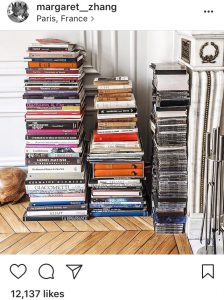What is a photobook?
According to the holy grail of internet knowledge – Wikipedia:
“A photo-book or photobook is a book in which photographs make a significant contribution to the overall content. A photo-book is related to and also often used as a coffee table book.”
Not only is that definition extremely vague, but it is also verges on devaluing the medium, specifically the section that states “it is often used as a coffee table book”. In an age whereby one of the defining features of a photo book is it’s aesthetic addition to your furniture, how do photo books remain culturally valuable?
What’s unique about a photobook?
As our world begins to swap more and more physical objects for a virtual counterpart, what importance do physical objects retain? A photobook is a physical object and with being so, comes a number of unique properties beyond it’s readiness as a beautiful prop for your Instagram feed.
(Isa)Bella Capezio gave us a great mini-presentation on photobooks today that explored the unique properties of photobooks, highlighted by some great examples.
Piece of Text
As Gerry Badger reinforces, a photobook is a piece of text, therefore the presumption is that a photobook can be ‘read’ in order to access it’s intended meaning. The meaning of the photobook lies within it’s reading as a text and as a book, rather than reading the meaning of individual photographs. Therefore, once someone decides to present images within a photobook, the meaning of the images will be distorted by the physicality, layout, structure and stylistic elements of the book itself, as well as cultural understandings of what a photobook is, and how we should interact with it.
Layout
The simple act of choosing a book means that only certain images can be seen at any one time and that relationships can be created in the singling out, pairing, or grouping of images on a page, or on opposing pages. For example:
Singling out: allows the image to stand alone and to be read in and of itself, within a series of images.
Pairing images: allows you to create a mirror between two images, where the reading of one informs the other, this could either be one of great contrast or of strong similarity.
Grouping images: allows you to create a relationship between a group of images, which can potentially make thematic or stylistic relationships more obvious and evident.
Structure
Choosing to present images within a photobook automatically creates a narrative in the way that the images unfurl themselves to the reader, even simplistic ordering of images will construct a narrative and create relationships between images. As a photographer it’s invaluable to be able to control the order and way in which the public will consume your work. It gives you ultimate control over the context surrounding each image and can encourage certain emotional reactions (shock, happiness, sadness, fear, horror) from the audience depending on the images placement in the series.
Stylistic Elements
Photobooks allow, based on the layout of images for motifs, reflections or mirroring to be created, for example:
Motifs
Repetitive elements presented throughout the photo book, that may include:
- Similar framing
- Same subject material
- Similar formatting of the images themselves upon the page, i.e. position of the photograph, within the frame of the page.
Reflections
Presenting images on opposite pages, or on ensuing pages that causes the viewer to read the image with the opposing or ensuing image in mind.
Mirrors
Utilising similar elements within a photograph to mirror aspects present within another image, can create comparisons or relationships between the images.
I hope to utilise the unique aspects of photobooks within my own creation of a photobook to add another dimension to my work and hopefully bring it to life!
Until next time,
Louise Alice Wilson





Leave a Reply